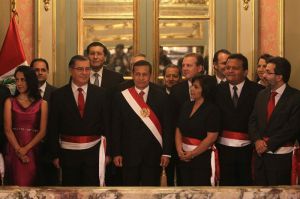President Ollanta Humala announced a major cabinet reshuffle on December 11, following the departure of Salomon Lerner Ghitis as president of the Council of Ministers. Lerner has been replaced by Oscar Valdés Dancuart, a retired colonel, previously interior minister. The reshuffle, which saw several left-of-centre figures dropped from the cabinet, has been widely seen as ushering in a period of more authoritarian government.
Minas Conga dispute
 The trigger for the changeover was the crisis over development of the £3.1 billion (US$4.8 billion) Minas Conga project in Cajamarca. This had caused widespread protest throughout the northern Cajamarca region in the previous three weeks. The Conga dispute quickly turned into a trial of strength between the protesters and the government. Although during the election campaign, Humala had pledged his support for peasant communities in contention with mining companies, he quickly changed his tune following his inauguration as president last July. In the case of Conga, one of Peru’s biggest potential mining projects, he made clear his support for its development, arguing that the plans adequately protected the interests of peasant communities.
The trigger for the changeover was the crisis over development of the £3.1 billion (US$4.8 billion) Minas Conga project in Cajamarca. This had caused widespread protest throughout the northern Cajamarca region in the previous three weeks. The Conga dispute quickly turned into a trial of strength between the protesters and the government. Although during the election campaign, Humala had pledged his support for peasant communities in contention with mining companies, he quickly changed his tune following his inauguration as president last July. In the case of Conga, one of Peru’s biggest potential mining projects, he made clear his support for its development, arguing that the plans adequately protected the interests of peasant communities.
The mining industry, which has huge lobbying power in Peru, has been among the first to welcome this turnaround. It accepted the need for a windfall tax, introduced soon after Humala took office (and which had been another of his campaign pledges), but demanded that the government take a firm stand towards social movements that protest against mining projects. There are a large number of protest movements up and down the country, many of them against mining concessions and the threat they pose to scarce water supplies.
Humala responded last week to the ongoing Conga protests by declaring a 60-day state of emergency in four provinces of Cajamarca and by ordering the deployment of large numbers of troops to the area. In doing so, he appears to have been heavily influenced by Valdés, at that point still interior minister, with whom he has a long-standing relationship (Valdés was one of Humala’s instructors in the military academy in the 1970s). Another key influence was Adrián Villafuerte, another retired colonel who has become a key advisor on strategy since Humala took office.
Confrontational approach
Despite protestations to the contrary, the government now seems embarked on a much more confrontational approach to mining disputes. This has been welcomed by a number of right-wing politicians, who see the removal of leftists from the cabinet as a highly positive move.
The show of force by the government on Conga will not subdue the anti-mining movement in Cajamarca, however, where peasant organisation is probably stronger than in any other region of Peru. New clashes are likely, and these could easily turn violent. Disputes may also flare up elsewhere.
One such flashpoint is the Rio Blanco project in Piura, to the north of Cajamarca on the border with Ecuador. Here local leaders have promised to resist any attempt by Zijin of China, the mine’s owners since 2007 (it was previously owned by Monterrico Metals of London), to push ahead with attempts to develop this potentially massive copper mine. In 2007, local communities voted overwhelmingly to prevent Monterrico from going ahead with this.
Left out
The cabinet reshuffle sees the exit of leftists like Aida García Naranjo (women’s affairs), Susana Baca (culture) and Ricardo Giesecke (environment). Another significant departure is Fernando Eguiguren (justice) who had been a powerful advocate of judicial reform. The new ministers include Lino Ginocchio (agriculture), Luis Peirano (culture), Manuel Pulgar Vidal (environment), Jorge Merino (energy and mines), Ana Jara (women’s affairs), Juan José Jiménez (justice), Alberto Otárola (defence), José Urquizo (production), José Villena (labour) and Daniel Lozada (interior).
Most of those associated with Perú Posible (PP), which had agreed to support Humala in July, have now withdrawn from the cabinet. PP’s leader, former president Alejandro Toledo, was scathing about the new direction being taken in government, saying that “we do not support the militarisation of social conflicts (…) we are against the militarisation of the government”.

